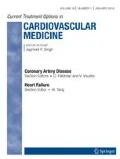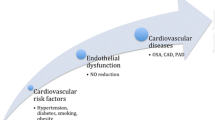Opinion statement
Cerebrovascular disease remains one of the most common causes of morbidity and mortality in the United States. There is strong evidence to implicate endothelial dysfunction in the initiation and progression of atherosclerosis and its complications. It is now well known that endothelial dysfunction represents a systemic syndrome involving multiple vascular beds, including the cerebral vasculature. Currently, no gold standard treatment for endothelial dysfunction exists. Nonetheless, several treatment strategies have been found to be helpful in improving endothelial function. A few of these strategies have been implicated in stroke risk reduction as well, adding another line of evidence to the relationship between endothelial function and cerebrovascular disease.
Similar content being viewed by others
References and Recommended Reading
Lerman A, Zeiher AM: Endothelial function: cardiac events. Circulation 2005, 111:363–368.
Anderson TJ, Uehata A, Gerhard MD, et al.: Close relation of endothelial function in the human coronary and peripheral circulations. J Am Coll Cardiol 1995, 26:1235–1241.
Bonetti PO, Lerman LO, Lerman A: Endothelial dysfunction: a marker of atherosclerotic risk. Arterioscler Thromb Vasc Biol 2003, 23:168–175.
Ganz P, Vita JA: Testing endothelial vasomotor function: nitric oxide, a multipotent molecule. Circulation 2003, 108:2049–2053.
Perticone F, Ceravolo R, Pujia A, et al.: Prognostic significance of endothelial dysfunction in hypertensive patients. Circulation 2001, 104:191–196.
Halcox JP, Schenke WH, Zalos G, et al.: Prognostic value of coronary vascular endothelial dysfunction. Circulation 2002, 106:653–658.
Schachinger V, Britten MB, Zeiher AM: Prognostic impact of coronary vasodilator dysfunction on adverse long-term outcome of coronary heart disease. Circulation 2000, 101:1899–1906.
Targonski PV, Bonetti PO, Pumper GM, et al.: Coronary endothelial dysfunction is associated with an increased risk of cerebrovascular events. Circulation 2003, 107:2805–2809. First study to show that coronary endothelial dysfunction is associated with increased cerebrovascular events.
McCarty MF: Up-regulation of endothelial nitric oxide activity as a central strategy for prevention of ischemic stroke—just say NO to stroke! Med Hypotheses 2000, 55:386–403.
O’Driscoll G, Green D, Taylor RR: Simvastatin, an HMG-coenzyme A reductase inhibitor, improves endothelial function within 1 month. Circulation 1997, 95:1126–1131.
Husain S, Andrews NP, Mulcahy D, et al.: Aspirin improves endothelial dysfunction in atherosclerosis. Circulation 1998, 97:716–720.
Doshi SN, McDowell IF, Moat SJ, et al.: Folate improves endothelial function in coronary artery disease: an effect mediated by reduction of intracellular superoxide? Arterioscler Thromb Vasc Biol 2001, 21:1196–1202.
Verhaar MC, Wever RM, Kastelein JJ, et al.: Effects of oral folic acid supplementation on endothelial function in familial hypercholesterolemia. A randomized placebocontrolled trial. Circulation 1999, 100:335–338.
He K, et al.: Folate, vitamin B6, and B12 intakes in relation to risk of stroke among men. Stroke 2004, 35:169–174.
Toole JF, Malinow MR, Chambless LE, et al.: Lowering homocysteine in patients with ischemic stroke to prevent recurrent stroke, myocardial infarction, and death: the Vitamin Intervention for Stroke Prevention (VISP) randomized controlled trial. JAMA 2004, 291:565–575.
Bonaa KH, NORVIT: Randomized trial of homocysteine-lowering with B-vitamins for secondary prevention of cardiovascular disease after acute myocardial infarction. Program and Abstracts from the European Society of Cardiology Congress 2005. Stockholm, Sweden; September 3–7, 2005.
Carr A, Frei B: The role of natural antioxidants in preserving the biological activity of endothelium-derived nitric oxide. Free Radic Biol Med 2000, 28:1806–1814.
Visioli F: Effects of vitamin E on the endothelium: equivocal? Alpha-tocopherol and endothelial dysfunction. Cardiovasc Res 2001, 51:198–201.
Lonn E, Bosch J, Yusuf S, et al.: Effects of long-term vitamin E supplementation on cardiovascular events and cancer: a randomized controlled trial. JAMA 2005, 293:1338–1347.
Prasad A, Andrews NP, Padder FA, et al.: Glutathione reverses endothelial dysfunction and improves nitric oxide bioavailability. J Am Coll Cardiol 1999, 34:507–514.
Andrews NP, Prasad A, Quyyumi AA: N-acetylcysteine improves coronary and peripheral vascular function. J Am Coll Cardiol 2001, 37:117–123.
De Haan JB, Crack PJ, Flentjar N, et al.: An imbalance in antioxidant defense affects cellular function: the pathophysiological consequences of a reduction in antioxidant defense in the glutathione peroxidase-1 (Gpx1) knockout mouse. Redox Rep 2003, 8:69–79.
Khan M, Sekhon B, Jatana M, et al.: Administration of N-acetylcysteine after focal cerebral ischemia protects brain and reduces inflammation in a rat model of experimental stroke. J Neurosci Res 2004, 76:519–527.
Lerman A, Burnett JC Jr, Higano ST, et al.: Long-term Larginine supplementation improves small-vessel coronary endothelial function in humans. Circulation 1998, 97:2123–2128.
Maxwell AJ, Zapien MP, Pearce GL, et al.: Randomized trial of a medical food for the dietary management of chronic, stable angina. J Am Coll Cardiol 2002, 39:37–45.
Blum A, Hathaway L, Mincemoyer R, et al.: Oral L-arginine in patients with coronary artery disease on medical management. Circulation 2000, 101:2160–2164.
Willmot M, Gray L, Gibson C, et al.: A systematic review of nitric oxide donors and L-arginine in experimental stroke: effects on infarct size and cerebral blood flow. Nitric Oxide 2005, 12:141–149.
Zhang F, Casey RM, Ross ME, Iadecola C: Aminoguanidine ameliorates and L-arginine worsens brain damage from intraluminal middle cerebral artery occlusion. Stroke 1996, 27:317–323.
Ryan M, McInerney D, Owens D, et al.: Diabetes and the Mediterranean diet: a beneficial effect of oleic acid on insulin sensitivity, adipocyte glucose transport and endothelium-dependent vasoreactivity. QJM 2000, 93:85–91.
Fuentes F, Lopez-Miranda J, Sanchez E, et al.: Mediterranean and low-fat diets improve endothelial function in hypercholesterolemic men. Ann Intern Med 2001, 134:1115–1119.
Fung TT, Stampfer MJ, Manson JE, et al.: Prospective study of major dietary patterns and stroke risk in women. Stroke 2004, 35:2014–2019.
Ziccardi P, Nappo F, Giugliano G, et al.: Reduction of inflammatory cytokine concentrations and improvement of endothelial functions in obese women after weight loss over one year. Circulation 2002, 105:804–809.
Woo KS, Chook P, Yu CW, et al.: Effects of diet and exercise on obesity-related vascular dysfunction in children. Circulation 2004, 109:1981–1986.
DeSouza CA, Shapiro LF, Clevenger CM, et al.: Regular aerobic exercise prevents and restores age-related declines in endothelium-dependent vasodilation in healthy men. Circulation 2000, 102:1351–1357.
Hambrecht R, Wolf A, Gielen S, et al.: Effect of exercise on coronary endothelial function in patients with coronary artery disease. N Engl J Med 2000, 342:454–460.
Lee CD, Folsom AR, Blair SN: Physical activity and stroke risk: a meta-analysis. Stroke 2003, 34:2475–2481.
Celermajer DS, Sorensen KE, Georgakopoulos D, et al.: Cigarette smoking is associated with dose-related and potentially reversible impairment of endotheliumdependent dilation in healthy young adults. Circulation 1993, 88(5Pt 1):2149–2155.
Kawachi I, Colditz GA, Stampfer MJ, et al.: Smoking cessation and decreased risk of stroke in women. JAMA 1993, 269:232–236.
Bonetti PO, Lerman LO, Napoli C, Lerman A: Statin effects beyond lipid lowering—are they clinically relevant? Eur Heart J 2003, 24:225–248.
Endres M, Laufs U, Huang Z, et al.: Stroke protection by 3-hydroxy-3-methylglutaryl (HMG)-CoA reductase inhibitors mediated by endothelial nitric oxide synthase. Proc Natl Acad Sci U S A 1998, 95:8880–8885.
Endres M: Statins and stroke. J Cereb Blood Flow Metab 2005, 25:1093–1110.
Adams H, Adams R, Del Zoppo G, Goldstein LB: Guidelines for the early management of patients with ischemic stroke: 2005 guidelines update a scientific statement from the Stroke Council of the American Heart Association/American Stroke Association. Stroke 2005, 36:916–923.
Anderson TJ, Elstein E, Haber H, Charbonneau F: Comparative study of ACE-inhibition, angiotensin II antagonism, and calcium channel blockade on flowmediated vasodilation in patients with coronary disease (BANFF study). J Am Coll Cardiol 2000, 35:60–66.
Prasad A, Narayanan S, Husain S, et al.: Insertion-deletion polymorphism of the ACE gene modulates reversibility of endothelial dysfunction with ACE inhibition. Circulation 2000, 102:35–41.
Sokol SI, Portnay EL, Curtis JP, et al.: Modulation of the renin-angiotensin-aldosterone system for the secondary prevention of stroke. Neurology 2004, 63:208–213.
Yusuf S, Sleight P, Pogue J, et al.: Effects of an angiotensin-converting-enzyme inhibitor, ramipril, on cardiovascular events in high-risk patients. The Heart Outcomes Prevention Evaluation Study Investigators. N Engl J Med 2000, 342:145–153. [Published erratum appears in N Engl J Med 2000, 42:1376.]
Sleight P, Yusuf S, Pogue J, et al.: Blood-pressure reduction and cardiovascular risk in HOPE study. Lancet 2001, 358:2130–2131.
Hornig B, Landmesser U, Kohler C, et al.: Comparative effect of ace inhibition and angiotensin II type 1 receptor antagonism on bioavailability of nitric oxide in patients with coronary artery disease: role of superoxide dismutase. Circulation 2001, 103:799–805.
Prasad A, Koh KK, Schenke WH, et al.: Role of angiotensin II type 1 receptor in the regulation of cellular adhesion molecules in atherosclerosis. Am Heart J 2001, 142:248–253.
Dahlof B, Devereux RB, Kjeldsen SE, et al.: Cardiovascular morbidity and mortality in the Losartan Intervention For Endpoint reduction in hypertension study (LIFE): a randomised trial against atenolol. Lancet 2002, 359:995–1003.
Vita JA, Keaney JF Jr: Hormone replacement therapy and endothelial function: the exception that proves the rule? Arterioscler Thromb Vasc Biol 2001, 21:1867–1869.
Thompson LP, Pinkas G, Weiner CP: Chronic 17betaestradiol replacement increases nitric oxide-mediated vasodilation of guinea pig coronary microcirculation. Circulation 2000, 102:445–451.
Rossouw JE, Anderson GL, Prentice RL, et al.: Risks and benefits of estrogen plus progestin in healthy postmenopausal women: principal results from the Women’s Health Initiative randomized controlled trial. JAMA 2002, 288:321–333. Large randomized study that looked into the role of hormone therapy to prevent chronic disease in women with an intact uterus in the decades of life following menopause.
Anderson GL, Limacher M, Assaf AR, et al.: Effects of conjugated equine estrogen in postmenopausal women with hysterectomy: the Women’s Health Initiative randomized controlled trial. JAMA 2004, 291:1701–1712. Large randomized, double-blind, placebo-controlled trial that tested the effects of the most commonly used postmenopausal hormone therapy preparation in the United States on chronic disease incidence in a healthy population of postmenopausal women.
Prentice RL, Langer R, Stefanick ML, et al.: Combined postmenopausal hormone therapy and cardiovascular disease: toward resolving the discrepancy between observational studies and the Women’s Health Initiative clinical trial. Am J Epidemiol 2005, 162:404–414.
Patrono C, Garcia Rodriguez LA, Landolfi R, Baigent C: Low-dose aspirin for the prevention of atherothrombosis. N Engl J Med 2005, 353:2373–2383.
Author information
Authors and Affiliations
Rights and permissions
About this article
Cite this article
Elesber, A.A., Bonetti, P.O. & Lerman, A. Endothelial function and cerebrovascular disease: Implications for diagnosis and treatment. Curr Treat Options Cardio Med 8, 213–219 (2006). https://doi.org/10.1007/s11936-006-0014-x
Issue Date:
DOI: https://doi.org/10.1007/s11936-006-0014-x




